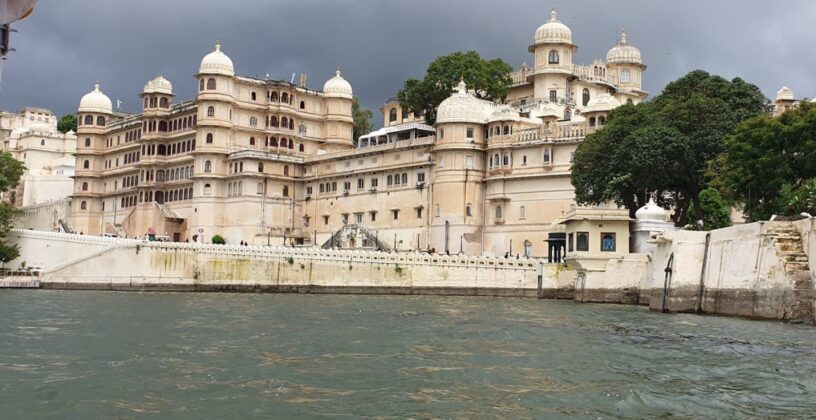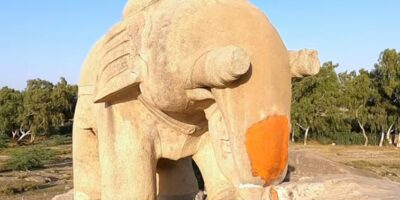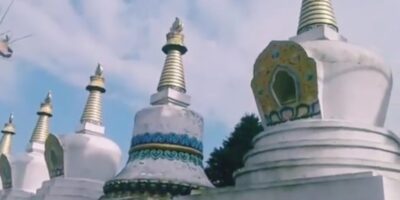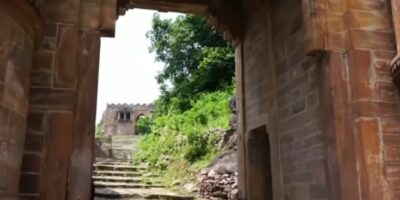City Palace Udaipur, Rajasthan is one of the most famous attractions of the city. City Palace is an example of the rich history and architecture of Udaipur. The City Palace Udaipur was constructed over a period of approximately 400 years. The construction of this palace was started in 1553 by Maharana Udai Singh II, the founder of Udaipur. Successive rulers made new constructions in the palace complex, as a result of which amazing architecture of Rajput style can be seen here.
Situated on the banks of Lake Pichola, City Palace offers breathtaking views of the lake and the surrounding hills. City Palace Udaipur The palace complex is a vast cluster of courtyards, gardens and buildings that showcase marble work, colorful tiles, delicate glass and mirror work and carvings. City Palace Udaipur reflects the prosperity and grandeur of the Rajput era.
Parts of City Palace Udaipur have been converted into luxury hotels, offering visitors the opportunity to experience royal hospitality amidst historical grandeur. City Palace is a popular venue for various cultural events including traditional Rajasthani performances, concerts and festivals. The City Palace in Udaipur stands as a symbol of the city’s rich heritage and has become one of the most visited tourist attractions in India every year.
City Palace Udaipur is a palace built in the sixteenth century in the city of Udaipur, Rajasthan by the Rajput kings of the Shishoudiya dynasty of Mewar, whose construction was completed over 400 years by 22 generations of Shishoudiya rulers. From time to time, different kings had been getting construction work done in City Palace Udaipur. The palace which is famous today as City Palace is shaped like a ship.
सिटी पैलेस उदयपुर | City Palace Udaipur in Hindi
City Palace Udaipur

City Palace Udaipur is the second largest palace in India. Mysore Palace is larger in area than the City Palace and is currently the largest palace in the country.
Before knowing about the City Palace, it is important to know about the Shishoudiya dynasty that preceded it. We all have read and heard about Panna Dhay. Panna Dhay was the foster mother of Maharana Udai Singh of the same Shishodia dynasty. When the Shishodia dynasty was going through internal conflict in Chittorgarh, Panna Dhay saved the life of Prince Udai Singh by losing his son Chandan.
After that when Uday Singh was sent to Kumbhalgarh. Later Udai Singh took back the Chittor fort and started ruling. Maharana Udai Singh was the 12th ruler of Mewar. Tired of the frequent Mughal attacks, Maharana Udai Singh wanted to build a new capital for himself.
History – City Palace Udaipur
The construction of City Palace Udaipur was started by Rana Udai Singh (II). Rana Udai Singh wanted to build a new capital of his own, separate from Chittorgarh. In the year 1559, Rana came here for hunting and he hunted a rabbit at the same place where the gate of the City Palace is now. Considering this place auspicious, Rana buried a stone here. On the advice of Goswami Prem Giri, who was doing penance on the nearby hill, Rana made this place his capital and started the construction of the palace.
This place is in Manak Chowk after entering from Tripolia Gate in City Palace. This is called Bhairav Sthan.
Sometimes leopards also enter Udaipur Palace and to catch them, a big cage has been kept near the gate. After catching, these animals are released back into the forests of the Aravali hills.
Raj Aangan was the first building to be built here. Maharana Pratap, son of Rana Udai Singh also constructed new buildings in this palace. Sheesh Mahal inside the palace was built by Maharana Pratap for his wife. Even after that, from time to time, different kings got construction done here. Due to the continuous invasions of the Mughals, most of the kings’ time was spent in wars, and due to this, the City Palace Udaipur was not built in one go but at different times over 400 years in its present form. 22 generations of kings of Mewar have done construction work in this palace.
After India became independent, the princely state of Mewar merged but the City Palace remained with the King of Mewar. Presently a large part of the City Palace houses museums. Some parts of the palace have been converted into hotels. The royal family lives in a part of the palace.
The City Palace built on the banks of Pichola Lake is a special attraction for the tourists coming to Udaipur and there is a constant flow of people coming here throughout the year. From the windows in the palace, the city of Udaipur can be seen far in different colors.
Ticket Price – City Palace Udaipur

You can buy tickets to enter the City Palace at the gate itself. City Palace Udaipur is open to tourists from 9.30 am to 5.30 pm, seven days a week. If you can reach the palace in the morning then that time is best for the City Palace tour. In the afternoon and beyond, many tourists come to see the palace and it becomes crowded. During the tourist season which is monsoon and winter, one should visit the palace in the morning itself.
Per person ticket for City Palace Udaipur is Rs 300. The ticket for children above 5 years of age is Rs 100. There are no tickets for City Palace for children below 5 years of age. Tour guides also stand in front of the ticket window. The tour of City Palace takes about 3 hours, so keep a water bottle with you. Although drinking water is available inside the palace, it may cause inconvenience when there is crowd.
If you have come on the City Palace tour with elders and children in the family, then keep some packaged dry snacks or snacks with you.
It is better that you take a tour guide with you before going on a tour of the City Palace. Guides here charge Rs 300-350. City Palace is a very big and historical palace and for a tour to know about such a palace, it is good to take a tour guide because only then you can know and understand well about the City Palace. Without a tour guide, the story related to every part of the City Palace remains unknown and there will be no special pleasure in seeing it.
Architecture – City Palace Udaipur

Now we know that it took 400 years of construction work for the City Palace to come to its present form and that is why its architecture can be seen in quite different forms due to it being constructed at different times. In the palace, not only the old Rajputana architecture can be seen but also the glass and stones used in the 19th century.
Different chambers of the palace were built during the rule of different kings. Inside the palace, there are also stones from China, glass from Belgium and fans running on kerosene oil from Italy.
The walls of the palace have been painted with natural colors and items related to the Ranas of Mewar have been kept for the visitors. During the palace tour, one not only gets to see the changing nature of history but the grandeur of the palace also impresses a lot.
Tripoliya Pol, Badi Pole – City Palace Udaipur
In Rajputi architecture, gate is called Pol and that is why every gate has Pol written along with its name. After going inside from Badi Pol i.e. Bada Gate, there is a magnificent Tripolia Pol which has three gates. The umbrellas built over it make it a very beautiful entrance. The effect of the first glimpse of Tripolia Pole is that the viewers realize that now they are about to see some historical period. There are a total of 7 chhatris over the Tripolia Pole. There used to be a total of 11 poles in the City Palace.

Manak Chowk – City Palace Udaipur

Manak Chowk is in front of Tripolia Gate. Manak Chowk is a large open area in which the rulers of Mewar used to hold their courts for the common people. Dussehra was celebrated in Manak Chowk itself and the king along with his courtiers used to participate in the public celebration. In this square, elephant fighting games used to take place for entertainment. Elephants used to pull each other towards themselves with their trunks as in tug of war. There was a wall between the elephants and the elephant who touched the wall first lost. The winning elephant was given special treatment and its sitting place was also very special. The elephants that won this competition were prepared for war.
The king used to sit and watch this game with important people of his court. In this square, there are platforms of different heights on which the king’s court and special people coming from outside were seated.
Presently there is a school in Manak Chowk in which children of the city study, there are also some shops and a museum of traditional art in the Chowk.
Maharana Pratap Hall – City Palace Udaipur
Toran Pole is a main pole/gate of the City Palace through which one can go inside the palace. As soon as you enter through this pole, you see 400 year old idols of Ganesha and Lakshmi. It is called Ganesh Deodhi.
After Ganesh Deodhi comes Maharan Pratap Room. In this room, the armour, spear and sword used by Maharan Pratap are kept for tourists to see. It is said that the total weight of Maharan Pratap’s iron armour, his sword and sword was 35 kg. Maharana Pratap’s famous golden spear is also kept here.

Paintings of the battle of Haldighati can also be seen outside this room. The war between Maharana Pratap and Man Singh is shown in this painting. Rajput kings had less elephants whereas Mughals had more elephants in their army. Maharana Pratap fought in the battle of Haldi Ghati by dressing his horse Chetak in the mask of a small elephant. It is said that due to this, the elephants considered him a small baby elephant and did not attack him during the war.
Raj Angan – City Palace Udaipur

Raj Angan is the first building to be built in the City Palace. The coronation of kings was done in this building. There is a small tub made from a single piece of marble. At the time of the king’s coronation, one lakh silver coins were filled in this tub and after the coronation, one-fourth of those silver coins were distributed among the public. This tub is also called Lakhtu. The remaining silver coins were used for state purposes.
Amar Vilas, Badi Mahal – City Palace Udaipur

Amar Vilas was built by Maharana Pratap’s son and his successor Rana Amar Singh. Amar Vilas and Bari Mahal are opposite to each other. Bari is a Mewari word which means forest. This is on the highest level of the palace where a small swimming pool has been built. There are trees and plants here at such a height. The special thing about this is that Amar Vilas is built on the highest part of the mountain. For this, the mountain was not cut down but a building was built on top of it. Here Rana used to celebrate the festival of Holi.
There are a total of 104 marble pillars in Bari Mahal which have beautiful carvings. All these pillars are made from a single stone without joining the pieces of marble. A beautiful view of Udaipur city can be seen from Amar Vilas and Bari Mahal.
Along with this, in a room there are cages used to keep the postmen i.e. pigeons of that time.

Sheesh Mahal – City Palace Udaipur

Sheesh Mahal was built by Maharana Pratap for his first queen Ajabde. This entire room is made of glass and natural colors have been used for painting in it. It is also known as Darpan Mahal. This is a grand and full of colors room. Flash photography is prohibited in this room. Its doors are made of ivory.
Bhim Vilas – City Palace Udaipur

Bhim Vilas is a very beautiful room painted in blue color. It was built by Raja Bhim Singh. The reign of Raja Bhim Singh was the longest among the kings of Mewar. This chamber has windows to look out from where the queens used to watch the celebrations taking place outside.
Maharana Bhopal Kaksh , Pritam Niwas – City Palace Udaipur

Maharana Bhupal Singh merged the princely state with India. Maharaja Bhupal Singh was the first king who merged his princely state with India in 1948. The Maharaja was made the head of the king of all the princely states of Rajasthan and he also helped the Government of India in the process of merger for other kings. There is a lift in the chamber of Maharana Bhupal Singh which is still in use. This lift was built in this room in 1940. It is said that this is the first lift used in India.
Choti Chitrashali – City Palace Udaipur

The kings of Mewar were Suryavanshi and worshiped the Sun and hence used to start their day with Surya Darshan. Along with this room there is a statue of Surya which has been made by planting gold on copper. This Sun Temple was also built during the time of Maharaja Bhupal. Maharaja Bhupal Singh could not walk. When Sun darshan was not possible during monsoon, he used to start his day by doing Surya darshan and worship at the Sun Temple here.
Badi Chitrashali – City Palace Udaipur
Badi Chitrashali was built by Rana Sangram Singh II during his reign. Here people of the royal family used to celebrate celebrations and festivals. Entertainment programs were also organized for the people of the royal family in this Chatrashali. This chitrashali has blue colored Chinese tiles and glass work.
China Chitrashala – City Palace Udaipur
This is an art gallery which has been built using Dutch and Chinese tiles.
Krishna Vilas – City Palace Udaipur

Krishna Vilas is dedicated to Princess Krishna who was the daughter of Maharana Bhim Singh. This room of the City Palace has a collection of paintings. The traditional rituals of the royal family are shown in these paintings.

Mor Chowk – City Palace Udaipur

Mor Chowk was built by Rana Karan Singh and the glass work in it was later done by Rana Sajjan Singh. This one was crazy special. Mor Chowk is considered to be the most beautiful square of the Palace. 5 peacocks have been made in this square and more than 5000 colorful pieces of glass have been used to make each peacock. The Maharaja used to hold meetings with his ministers in this square of the City Palace and festivals were also celebrated here with the ministers. Dance and song programs were also organized in Mor Chowk for the entertainment of the king and the courtiers.
Moti Mahal – City Palace Udaipur

Moti Mahal is a chamber decorated with glass and mirrors. It was built by Maharaja Karan Singh. A beautiful view of Udaipur can be seen from the windows of this palace. Maharaj Karan Singh also used to live in this part of the palace.
Manak Mahal – City Palace Udaipur

It was used for Sun worship and as a monsoon palace. Here the king sometimes used to eat food with his family. The view of Udaipur can be seen from the windows of Manak Mahal.
Maharaja Fateh Singh Chair
There is a special chair kept in City Palace Udaipur which has a story related to it. When the British Emperor George V held a court in Delhi, he also invited the kings of all the princely states of India. The then king of Mewar, Fateh Singh, refused to attend this court and hence his chair remained vacant in that meeting. This chair was later gifted to Raja Fateh Singh as a symbol of respect for Mewar. Two British horses, Expert and Redlad, were also gifted to him.
Dilkhush Mahal – City Palace Udaipur
Dilkhush Mahal was built by Maharaj Karan Singh for the women of the royal family. There are many windows and balconies in this palace. There are red, green and blue colored glass curtains on the windows of this palace. Through these windows the queens could see the general court but no one from outside could see the queens.
Vani Vilas – City Palace Udaipur
Maharaja Sajjan Singh built the first special library in Udaipur in 1875 and poet Shyamaldas started writing the history of Mewar sitting in the Vani Vilas room.
Janana Mahal – City Palace Udaipur

Zenana Mahal City Palace was built for the women of the royal family in Udaipur. This part of the palace was constructed during the reign of Rana Sangram Singh. Women of the royal family used to gather in Zanana Mahal on Teej festival.
In the Zenana Mahal, there are rooms for the queens where they used to get ready, as well as living rooms for the maids and also a room for their dressing, which has many mirrors on the wall so that many maids can get ready at the same time. Were.

This room in City Palace Udaipur used to be the meeting room of the queens.
Museum – City Palace Udaipur
City Palace Udaipur Museum displays silver utensils, weapons, decorations of stubborn horses, palanquins and carriages, clothes and shawls of kings and princes used by the royal family. In this museum, those statues are also kept which were mutilated by the invaders from time to time. Apart from this, photographs of the present king and his family are also kept for viewing in this museum.

Darbar Hall – City Palace Udaipur
Durbar Hall is the new part of City Palace Udaipur. It was built in 1909. Durbar Hall was earlier known as Minto Hall because its foundation stone was laid by Lord Minto, the then Viceroy of India. In the Durbar Hall, things related to the rulers of Mewar and their paintings are displayed. In this hall is the famous Crystal Gallery which is the largest crystal gallery in the world.
Fateh Prakash Palace – City Palace Udaipur
Fateh Prakash Palace has now been converted into a hotel. This hotel is often used in weddings of celebrities.
City Palace Udaipur Hindi – Films
City Palace Udaipur can also be often seen in films. The famous song “Ghunghat Ki Aad Se Dilbar Ka” was shot in this palace. A few years ago, a song and some parts of the film Prem Ratan Dhan Payo were shot in this palace. Apart from Bollywood films, some parts of the palace are also taken on rent for weddings of big business owners. Outside Bollywood, some Hollywood films like James Bond series films have also been shot in City Palace Udaipur.




Leave a Reply